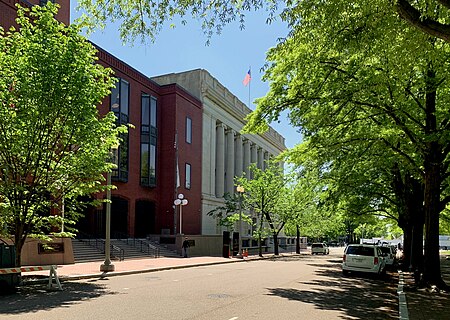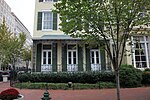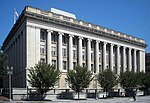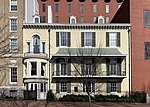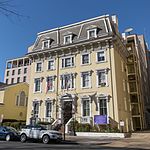The Benjamin Ogle Tayloe House is a Federal-style house located at 21 Madison Place NW in Washington, D.C., in the United States. The house is on the northeast corner of Madison Place NW and Pennsylvania Avenue NW, directly across the street from the White House and the Treasury Building. Built in 1828 by Benjamin Ogle Tayloe, son of Colonel John Tayloe III (who built the famous Octagon House), the house became a salon for politically powerful people in the federal government.
Phoebe Tayloe inherited the house upon Tayloe's death in 1868. After she died in 1881, more than 200 marble statues, bronze sculptures, fine furniture, and paintings in the house were donated to the Corcoran Gallery of Art. Phoebe Warren Tayloe's niece, Elizabeth H. Price, inherited the house in 1882 and later sold it to Senator Don Cameron of Pennsylvania for $60,000 in 1887. In around 1896, the U.S. Senate passed legislation which would have made the building the official residence of the Vice President of the United States, but the House of Representatives failed to act on the bill. Cameron leased the house to Vice President Garret Hobart from March 1897 until the fall of 1899 and the press and public nicknamed the house the "Historic Corner" and the "Cream White House" for the large number of politically important visitors and meetings held on the premises, with esteemed guests such as the International Boundary Commission and Prince Albert of Belgium. Hobart's failing health led the family to leave the Tayloe House in the fall of 1899 and Cameron then leased the home to Republican Senator Mark Hanna from January 1900 to 1902. Hanna's important political discussions of the moment with William McKinley and Theodore Roosevelt over substantial breakfasts of corned beef hash and pancakes became famous.
The Congressional Union for Woman Suffrage leased the house in the fall of 1915, and made the building its headquarters for two years. The Cosmos Club had considered purchasing the house from the Tayloe family in 1885 and eventually bought it in December 1917. They vacated it in 1952 to move to their new headquarters; the building was purchased by the U.S. government and used for offices. From October 1958 until November 1961, the house was the headquarters of the National Aeronautics and Space Administration (NASA).
Nearly razed to the ground in 1960 along with other buildings on Lafayette Square, successful lobbying and support from the newly elected Kennedy administration in 1961 led to the original proposals to gut the building being dropped. First Lady Jacqueline Kennedy was instrumental in persuading architect John Carl Warnecke, a friend of her husband, to create a design that would incorporate the new buildings with the old, based on the architectural theory of contextualism. The Cutts-Madison House, Cosmos Club building, and Benjamin Ogle Tayloe House were joined, and a courtyard built between them and the National Courts building. The building has remained part of the National Courts Building complex ever since, and is now listed on the National Register of Historic Places.
